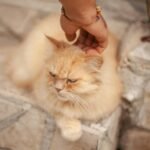Have you ever caught your cat staring at you with those soulful eyes and wondered what’s really going on in their mysterious little minds? Cats are masters of routine and emotion, even if they don’t always show it in obvious ways. If you’re a devoted cat lover, you know there’s something magical about the bond you share with your feline friend. But how can you tell if your cat is truly building a strong emotional routine with you? Understanding the subtle clues can transform your relationship and deepen your connection in ways you never imagined.
Recognizing Consistent Morning and Evening Rituals

One of the clearest signs that your cat is developing an emotional routine is their unwavering predictability at certain times of the day. Does your cat greet you every morning with a gentle nuzzle or a soft meow? Maybe they curl up by your side as you unwind in the evening. These habits aren’t just about food or comfort—they’re a sign that your cat feels emotionally secure in your presence. Over time, you might notice your cat anticipating your movements, waiting by the door as you wake up, or settling in beside you as you end your day. This regularity is their way of saying, “You’re important in my world.” When these routines are disrupted, your cat may seem restless or anxious, highlighting just how vital these emotional anchors are in their daily life.
Watching for Attachment Behaviors and Seeking Affection

Cats may have a reputation for being aloof, but many show their emotional routines through clear displays of attachment. Does your cat follow you from room to room, or insist on being in the same space as you? These actions are not random—they’re purposeful signs of affection and trust. Purring, head-butting, and gentle kneading on your lap are all ways your cat expresses their bond. If your cat routinely seeks out your attention, especially during stressful or quiet moments, it’s a strong indication that you are their emotional anchor. Over time, these affectionate gestures become part of their everyday routine, cementing a deep and enduring connection.
Observing Playtime Patterns and Shared Activities

Playtime is more than just a way for cats to burn energy—it’s an important part of their emotional routine. You might notice your cat bringing you toys at the same times each day, or initiating playful chases when you’re relaxed and open to engagement. These patterns reveal your cat’s desire for interaction and their reliance on you for emotional stimulation. When play becomes a regular, shared activity, it strengthens the bond between you and your pet. Some cats even invent their own games with their humans, turning simple objects like paper balls or string into tools for connection. If your cat seems to look forward to these moments, it’s a sure sign they’re emotionally invested in their routines with you.
Listening to Vocal Cues and Communication Changes

Cats use a surprising array of vocalizations to communicate their needs, moods, and routines. From soft chirps to demanding meows, each sound can indicate where your feline stands emotionally. If your cat has developed a habit of “talking” to you at specific times—perhaps when you get home or before meals—it’s a routine that carries emotional significance. You may even notice new sounds or changes in pitch that coincide with moments of excitement, anticipation, or affection. By responding consistently to these cues, you reinforce your cat’s emotional routine, making them feel heard and understood.
Noticing Grooming Habits and Mutual Care

Grooming is a deeply personal act for cats, not just a matter of hygiene. When your cat grooms themselves in your presence, or even extends their grooming to you by licking your hand or hair, it’s a potent sign of trust and routine. This “allogrooming” behavior is common among bonded cats and, when directed at humans, means you’re part of their inner circle. If your cat regularly grooms themselves after you pet them or sits close by during your own self-care routines, they’re participating in a shared ritual. These habits, repeated daily, form the backbone of a strong emotional routine and reinforce their sense of safety and belonging.
Responding to Emotional Cues and Moods

Cats are astute observers of human emotion. If your cat seems to comfort you during times of sadness or stress—by sitting closer, purring, or simply being present—it’s a powerful indication that they’re attuned to your emotional state. Over time, you might find that your cat’s routine includes checking in on you when you’re not at your best. This empathetic behavior isn’t accidental; it’s a sign of a well-established emotional connection. If your cat’s actions shift in response to your moods, it’s a testament to the depth of your bond and the routine they’ve built around your emotional well-being.
Tracking Feeding and Treat Rituals

Feeding time is about much more than nutrition for many cats; it’s a cornerstone of their emotional routine. You may notice your cat waiting patiently in their favorite spot, meowing with anticipation, or even performing a little “happy dance” as you prepare their food. The way your cat interacts with you during these moments—whether it’s rubbing against your legs or making direct eye contact—demonstrates their reliance on you for comfort and consistency. Special treats or shared snacks often become rituals that reinforce your bond, especially when they’re given at the same time or in the same way each day. These feeding routines become cherished moments of connection.
Reacting to Changes and Demonstrating Loyalty

One of the most telling signs that your cat has built a strong emotional routine is how they react to changes in your schedule or environment. If you come home late, travel for a few days, or change your daily habits, your cat may protest or exhibit anxious behaviors. Some cats become more vocal, while others may withdraw or display extra affection upon your return. This reaction isn’t about being stubborn—it’s a sign of their loyalty and the importance of the routines you share. Cats thrive on predictability, and any disruption to their emotional routine can feel unsettling. Their response to change underscores just how deeply they value your presence and the life you’ve built together together.

Growing up traveling and experiencing new cultures and wonders, I have had a passion for nature, adventuring, photography, and videography. I am currently working towards a BSc in Biodiversity and Ecology at Stellenbosch University, and I hope to specialise in Marine Sciences one day.
Please send any feedback to Feedback@animalsaroundtheglobe.com






